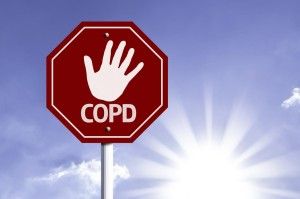Welcome back to our series for National COPD Awareness Month. Today we’re going to take a deeper look at what COPD is and discuss a key method for preventing it.
As previously discussed, COPD sufferers regularly experience wheezing, coughing, and shortness of breath. In fact, some COPD sufferers report difficulty breathing during extremely basic and typically non-taxing activities such as putting on sunscreen. There are two general complimentary causes for COPD – the breakdown of lung tissue and problems within the small airways. Although they are both present in COPD sufferers, the relationship between the two varies from patient to patient.
The breakdown of lung tissue is a simple description of Emphysema. The tissue in the lungs begins to deteriorate. Specifically, the grape-like clusters of alveoli (air sacs) get weak to the point that they eventually rupture. Due to the weakened state of the tissue, they don’t heal. Instead, they form larger air sacs. This reduces the surface area of the lungs and makes them less effective. This damage can’t be reversed. The second contributing factor is small airways disease – clinically referred to as constrictive bronchiolitis – and is defined by inflammation and scaring in the bronchiole. The damage done to both the alveoli and bronchiole results in an extremely weakened and eventually ineffective respiratory system.
Surprisingly, it isn’t just the inability to breathe deeply which harms COPD sufferers – they also can’t exhale as effectively as healthy people. This phenomenon is called air trapping and can cause additional complications, such as the replacement of lung tissue with air pockets.
While there are some other causes of COPD, such as long-term exposure to chemicals – this damage is most often the result of smoking. COPD ranks high among the many reasons to avoid cigarettes and it can’t be stressed enough how important it is to quit. In fact, as of 2008 – the World Health Organization has instituted a non-recruitment policy for smokers and will not hire anyone who is unwilling to quit smoking.
Perhaps you or someone you care about is a smoker? The dangerous long-term effects of smoking may seem intangible or too unreal to help inspire someone to quit. Instead of focusing on the abstract consequences try to consider quitting in the context of the immediate benefits, because there are many.
Almost immediately – within just twenty minutes of the last cigarette – your blood pressure begins to drop, so does your heart rate. After just twelve hours, the level of carbon monoxide in your blood drops. Lung function and circulation improve in just two-three months. Many former smokers report that food begins to taste better. Although cigarette prices vary from state to state, the money saved by quitting is nothing to shake a fist at.
As the years pass, the benefits begin to pile up – the risk for coronary heart disease decreases, a variety of cancers become less likely, and for some who quit early enough their lungs may begin to physiologically resemble those of someone who has never smoked.
Finally, it eliminates the risk of COPD – one of the leading causes of death in the United States. Although quitting won’t cure anyone of COPD, it will help prevent any further damage.
The Centers for Disease Control offers some great advice for people ready to give up smoking, from how to deal with cravings and withdrawal, to how to keep smoke free forever. They can help you prepare to quit smoking and offer advice to make sure you stay on track.
The Smoke Free website also has a lot of info to help you give up. You can also get support over the phone by calling the QUIT NOW helpline at 1-800-QUIT-NOW.
Tobacco Free Life offers in depth guides on how to quit smoking, reasons to quit, preparing to quit and “staying quit” guides.
It is important to remember that there are other factors that contribute to the development of COPD. We can’t change our genetics and sadly, many people who are regularly exposed to some of the environmental causes may not be able to prevent it. While smoking is not the only cause of COPD, it is the most avoidable one.
Empathy, support, and encouragement are three things which you can offer to someone who is struggling to quit smoking. You may think they’ve heard it all, and perhaps they have, but the risk of COPD and other complications should help to fight the silence. Perhaps focusing on the benefits of quitting, instead of the perils of smoking, will help them hear you better. It’s too important not to try.
While diagnoses and mortality rates for COPD remain on the rise, knowledge about the disease still remains low. This is why COPD Awareness Month is something to take seriously. Getting the word out is one way to help combat this life threatening condition.
From how to spot early symptoms right through to advice on how to pay for COPD care, the American Lung Association website has a very comprehensive guide on all aspects of COPD. As part of the campaign Learn More Breathe Better, the National Heart Lung and Blood Institute have put together a wealth of information on every aspect of the disease. Furthermore, as part of their Breathe Better network, they have a comprehensive list of Breathe Better events near to you. These local support groups are designed to offer help and advice to people with COPD and their families.
Thank you for tuning in to our series on COPD. We hope you found this information interesting and helpful. If you enjoyed these articles please tune in to our latest news section on the Austin Air website as we continue to update it with health-related articles every several days.
